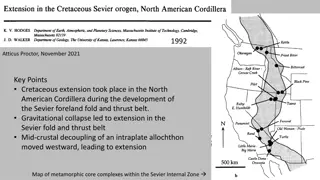
Nuclear Life Extension and New Build Prospects in Europe - INRAG Study Overview
Discover the current landscape of retired, operational, and under-construction nuclear reactors in Europe, as well as the prospects for new capacity and risks associated with lifetime extensions. Explore insights from the INRAG study presented by Professor Steve Thomas from the University of Greenwich, UK. Gain valuable information on the status of commercial nuclear plants, reactor retirements, and future orders and prospects for nuclear power in Europe.
Download Presentation

Please find below an Image/Link to download the presentation.
The content on the website is provided AS IS for your information and personal use only. It may not be sold, licensed, or shared on other websites without obtaining consent from the author. If you encounter any issues during the download, it is possible that the publisher has removed the file from their server.
You are allowed to download the files provided on this website for personal or commercial use, subject to the condition that they are used lawfully. All files are the property of their respective owners.
The content on the website is provided AS IS for your information and personal use only. It may not be sold, licensed, or shared on other websites without obtaining consent from the author.
E N D
Presentation Transcript
Prospects for nuclear life-extension & new-build in Europe Professor Steve Thomas University of Greenwich, UK INRAG Study Risks of lifetime extensions of old nuclear power plants , April 26, Online
Outline Retired reactors in Europe Prospects for new nuclear capacity in Europe Life extension policies in Europe INRAG Study - Risks of lifetime extensions of old nuclear power plants 2
Status of commercial nuclear plants in Europe Capacity in operation: 116,677MW in 16 countries. 53% France Capacity under construction: 9,590MW in 5 countries Capacity retired: 39,792MW in 10 countries. 80% of retired capacity in 4 countries, 45% in Germany INRAG Study - Risks of lifetime extensions of old nuclear power plants 3
Retired commercial reactors in Europe (MW (no of units)) Germany 18078 (24) France 5308 (10) UK 4588 (27) Sweden 4044 (6) Lithuania 2370 (2) Bulgaria: 1632 (4) Italy 1423 (4) Spain 1067 (3) Slovakia 909 (3) Switzerland 373 (1) INRAG Study - Risks of lifetime extensions of old nuclear power plants 4
Prospects for new capacity: Reactors under construction Finland: Olkiluoto expected completion 2022 France: Flamanville expected completion 2023+ UK: Hinkley Point C (2), expected completion 2026-28 Slovakia: Mochovce (2), construction started 1987, awaiting start-up Belarus: Ostrovets (2), unit 1 testing, unit 2 to follow INRAG Study - Risks of lifetime extensions of old nuclear power plants 5
Prospects for new capacity: Orders & Prospects Orders Finland: Hanhikivi (1), Rosatom, construction start 2022+ Hungary: Paks (2), Rosatom, construction start 2023 Prospects UK: Wylfa, Oldbury, Moorside abandoned, Sizewell, Bradwell in serious doubt France: 6 orders for EPR 2 being costed. Likelihood of orders unclear Czechia: Dukovany (2), completion by 2032 Poland: Zarnowiec? (2), first reactor by 2033 Romania: Cernavoda (2) 4 reactors ordered 1980 but continued failure to finance completion of last 2 Bulgaria: Belene (2) equipment paid for & delivered by Rosatom. Plans for Westinghouse to build it Slovenia, Estonia, Lithuania, Slovakia? INRAG Study - Risks of lifetime extensions of old nuclear power plants 6
Life extension: Countries with fixed licensing periods Switzerland: 2960MW (4). Formerly closure after 50 years, 2020-34. But now closure by 2050 with 60-year life. Beznau 1 world s oldest operating reactor Belgium: 5942MW (7). Closure by 2025, 40-50 years life. Plant owner, Engie, has abandoned work to life extend 2 newest reactors to 2045 Netherlands: 482MW (1). Closure after 60 years, 60 years life in 2033 but owner lobbying for further life-extension Spain: 7121MW (7). Previously closure after 40+ years, last by 2030. Policy now final closure by 2035 with average age 45 years All 4 countries have or have had phase-out policies but all except Belgium trying to extend lives. INRAG Study - Risks of lifetime extensions of old nuclear power plants 7
Life extension: Countries with open licensing periods Finland: Loviisa running for 50 years (2027, 2030), Olkiluoto running for 60 years (2038, 2040). Owners seeking a further 20 years for Loviisa Sweden: 6 remaining reactors expected to operate for 60 years to 2040-45 France: ASN has specified measure needed for 10-year life-extension to 50 years. 2 closed in 2020 & 12 more to be closed by 2035 (by then 50+ years old) on government orders. EDF wants to operate other 44 reactors for up to 60 years (to 2062) UK: 7 AGR stations & 1 PWR. Reactors operate as long as they are licensable. Irreparable graphite issues & corrosion mean scope for life-extensions at AGRs limited. 2 stations closed in 2022 after 46 years, 2 closed in 2024 after 35 years, 2 closed in 2030 after 41 years, 1 planned to run till 2028 but may close in 2021 due to corrosion. PWR expected to operate for 50+ years (2045+) Apart from UK, all countries seeking at least 60 years of operation INRAG Study - Risks of lifetime extensions of old nuclear power plants 8
Life extension: Eastern Europe Armenia: 1 reactor licensed to operate to 2026 (46 years). Now seeking 10 more years with help from Rosatom. Sited in area of seismic and geopolitical concern Bulgaria: 2 reactors expected to operate to 2050, 60 years Czechia: 4 older reactors till 2045, 60 years, 2 newer ones till 2060 for 60 years Slovakia: expects to run its reactors for 60 years till 2045-2060 Hungary: expects at least 50 years till 2037 Romania: 2 reactors 15 & 25 years old (Candu). Major rebuild (retubing) for unit 1 expected 2026 leading to further 30 years operation Slovenia: Krsko (Westinghouse PWR) licensed for 60 years to 2043 Reactors all expected to operate for about 60 years INRAG Study - Risks of lifetime extensions of old nuclear power plants 9






















